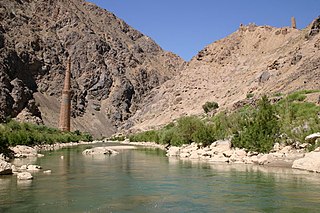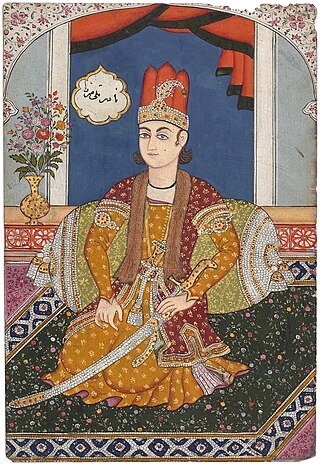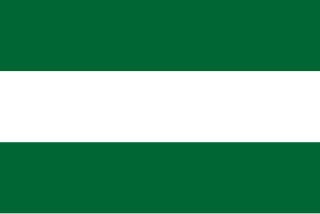
Ahmad Shāh Durrānī, also known as Ahmad Shāh Abdālī, was the founder of the Durrani Empire and is often regarded as the founder of modern Afghanistan.

Soltan Hoseyn was the Safavid shah of Iran from 1694 to 1722. He was the son and successor of Shah Suleiman.

Shahrokh Mirza, better known by his dynastic title of Shahrokh Shah was the Afsharid king (shah) of the western part of Khorasan from 1748 to 1796, with a two-month interruption. A grandson of the Iranian conqueror Nader Shah, Shahrokh was the son of Reza Qoli Mirza Afshar and his Safavid wife Fatemeh Soltan Begom, who was the sister of Tahmasp II, the penultimate Safavid shah of Iran. Shahrokh's half-Safavid descent made him stand out amongst his Afsharid relatives, and was used to bolster the legitimacy of his grandfather. After the assassination of Nader Shah in 1747, his nephew Ali-qoli Khan, ascended the throne in Mashhad and had all of Nader Shah's descendants in fortress of Kalat massacred. Shahrokh was spared in case his Safavid lineage would come to use, and was instead kept in the fortress as a prisoner. While Adel Shah was battling his rebellious younger brother Ebrahim Mirza, a party of Turkic, Kurdish, and Arab tribal leaders took advantage of his absence and installed Shahrokh on the throne. Both Adel Shah and Ebrahim were eventually defeated and killed, but Shahrokh was not long afterwards overthrown by a party of dissident tribal leaders, who installed the Safavid pretender Mir Sayyed Mohammad on the throne. Shahrokh was soon blinded at the instigation of Mir Alam Khan Khuzayma and other leading nobles, much against Suleiman II's will.

The Hotak dynasty was an Afghan monarchy founded by Ghilji Pashtuns that briefly ruled portions of Iran and Afghanistan during the 1720s. It was established in April 1709 by Mirwais Hotak, who led a successful rebellion against the declining Persian Safavid empire in the region of Loy Kandahar in what is now southern Afghanistan.

The Battle of Damghan or Battle of Mehmandoost was fought on September 29 to October 5, 1729, near the city of Damghan. It resulted in an overwhelming victory for Nader Shah and the Safavid cause he had taken up, though by itself it did not end Ashraf's rule in Iran, it was a significant triumph which led to further successes in the following engagements of the campaign to restore Tahmasp II to the throne. The battle was followed by another one in Murcheh-Khort, a village near Isfahan. Nader's forces were victorious in both battles, which led him to remove the Ghilzai Afghan dynasty from their short stay on the Persian throne. The Hotakis were forced back to their territory in what is now southern Afghanistan.

Ali-qoli Khan, commonly known by his regnal title Adel Shah was the second shah of Afsharid Iran, ruling from 1747 to 1748. He was the nephew and successor of Nader Shah, the founder of the Afsharid dynasty.

The siege of Kandahar began when Nader Shah's Afsharid army invaded southern Afghanistan to topple the last Hotaki stronghold of Loy Kandahar, which was held by Hussain Hotaki. It took place in the Old Kandahar area of the modern city of Kandahar in Afghanistan and lasted until March 24, 1738, when the Hotaki Afghans were defeated by the Persian army.

The Ottoman–Persian War of 1730–1735 or Ottoman–Iranian War of 1730–1735 was a conflict between the forces of Safavid Iran and those of the Ottoman Empire from 1730 to 1735. After Ottoman support had failed to keep the Ghilzai Afghan invaders on the Persian throne, the Ottoman possessions in western Persia, which were granted to them by the Hotaki dynasty, came under risk of re-incorporation into the newly resurgent Persian Empire. The talented Safavid general, Nader, gave the Ottomans an ultimatum to withdraw, which the Ottomans chose to ignore. A series of campaigns followed, with each side gaining the upper hand in a succession of tumultuous events that spanned half a decade. Finally, the Persian victory at Yeghevard made the Ottomans sue for peace and recognize Persian territorial integrity and Persian hegemony over the Caucasus.

The campaigns of Nader Shah, or the Naderian Wars, were a series of conflicts fought in the early to mid-eighteenth century throughout Central Eurasia primarily by the Iranian conqueror Nader Shah. His campaigns originated from the overthrow of the Iranian Safavid dynasty by the Hotaki Afghans. In the ensuing collapse and fragmentation of the empire after the capture of the Iranian capital of Isfahan by the Afghans, a claimant to the Safavid throne, Tahmasp II, accepted Nader into his service. After having subdued north-west Iran as well as neutralising the Abdali Afghans to the east and turning Tahmasp II into a vassal, Nader marched against the Hotaki Afghans in occupation of the rest of the country. In a series of incredible victories the Afghans were decimated and Tahmasp II returned to the throne as a restored Safavid monarch.

The conquest of Khorasan by Safavid loyalist forces against separatists in Khorasan was Nader Shah's first major military campaign which he waged on behalf of the new Safavid pretender to the throne, Tahmasp II. It would propel him into the centre of the political landscape of war-torn early eighteenth-century Persia.
The Battle of Sangan, was an engagement involving the Loyalist forces of Tahmasp II of Safavid Iran led by Nader and the Abdali Afghan tribes in and further beyond southern Khorasan in the autumn of 1727. This armed struggle was one of the initial battles between the resurgent Safavid cause and that of the Afghans. The engagement technically ended in a Safavid victory.

The Campaign of Herat consisted of a series of intermittent and fluid engagements culminating in the finale of Nader's military operations against the Abdali Pashtuns. Nader having recently concluded a successful campaign against his own monarch and prince, the badly humiliated Tahmasp II, set out from Mashad on 4 May 1729, making sure that the Shah also accompanied him on this journey where he could be kept under close supervision.

The Battle of Kafer Qal'eh was a series of clashes which decided the outcome to the Herat Campaign. In its culminating stage the battle bears some resemblances to the battle of Sangan although it was both preceded and succeeded by numerous other minor skirmishes and engagements.

The restoration of Tahmasp II to the Safavid throne took place in the latter part of 1729 by a series of battles fought between Nader, Tahmasp's commander-in-chief and Ashraf Hotaki. Despite nominally bringing Tahmasp to the seat of power, true authority still rested with Nader who had ever since the debacle in northern Khorasan managed to seize Tahmasp II as his vassal. Hotak was defeated. As for Afghan rule, the Ghilzai Afghans were ejected from the Iranian Plateau permanently and in the following years were re-annexed by Nader whence they were once again absorbed into the Persian empire. The Safavids under Tahmsap II were restored.

The campaign of 1731 was a failed attempt by Tahmasp II of the Safavid dynasty to launch an offensive into Ottoman held Caucasus which ended in a disastrous defeat with all of Nader's gains during the previous year being lost. The result of this particular military catastrophe was still overturned with Nader's return from the east but would have much more significant impact on the Safavid dynasty itself as Tahmasp II sealed his own fate by initiating this ill fated expedition.

Reza Qoli Mirza Afshar was the eldest son of Nader Shah, King of Afsharid Iran. After his father's coronation in 1736, Reza Qoli, aged 17, became the Governor of the province of Khorasan. During his tenure, he subdued rebellious khans and marched up to Bukhara to put an end to the Khanate of Bukhara, his father's enemies. Before heading off to India, Nader Shah appointed Reza Qoli the regent of Iran. Reza Qoli ensured peace through harsh measures when collecting taxes and executed people for petty crimes. He had Tahmasp II and Abbas III, two pretenders to the throne, killed, which caused an uproar among the people. When Nader Shah returned from India, he dismissed Reza Qoli as regent, snubbing him for his actions during the regency.

After the succession of setbacks the Abdalis of Herat had faced in the campaign Allahyar Khan decided to sully out for a last engagement to decide the issue. Unfortunately yet again the charge of the Afghan horsemen was broken up by the disciplined fire of the Persian line musketeers and flank attacks by the supporting Persian cavalry. Allahyar Khan was left no choice but to withdraw his battered army behind the walls of Herat in the hopes of withstanding the coming siege. An intense bombardment of the city ensued with heavy cannon and mortars battering the city's defences. After consulting with his advisers Allahyar Khan was convinced of the futility of further resistance. Peace terms were offered and the Abdalis agreed to sear fealty to Tahmasp II as the rightful ruler of Persia and Herat. Thus the Abdalis were brought under Persian suzerainty.

The Guarded Domains of Iran, commonly referred to as Afsharid Iran or the Afsharid Empire, was an Iranian empire established by the Turkoman Afshar tribe in Iran's north-eastern province of Khorasan, establishing the Afsharid dynasty that would rule over Iran during the mid-eighteenth century. The dynasty's founder, Nader Shah, was a successful military commander who deposed the last member of the Safavid dynasty in 1736, and proclaimed himself Shah.
The Rebellion of Sheikh Ahmad Madani(Persian: شورش شیخ احمد مدنی) was a revolt in the Garmsirat region of Iran from January 1730 as the Hotaks were being pushed out of Iran up until May 1734 when Sheikh Ahmad Madani was captured. However, remnants of the rebellion continued to fight until the middle of June 1734 before it was finally crushed.

The Principality of Herat, the Emirate of Herat, the Herat Khanate or simply Herat was a state in Afghanistan from 1793 to 1863, and one of the three main khanates that existed in 19th century Afghanistan after the breakup of the Durrani Empire.


















